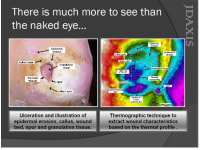
JDAxis and physicians from the University of Arizona’s Medical School have developed a patent pending medical device which is a proposed portable, non-invasive, handheld and intelligent wound assessment cameral based on infrared imaging. The technology consists of a thermal camera, imaging system and microcomputer that generates a thermographical analysis and visual representation in the form of color coded images. The time dependant images are aligned and synchronized so the changes can be animated in the visual and thermal spectrum.
The technology would provide a diagnostic medical device to locate, evaluate, and recognize areas of degradation in a wound, inflammation, and premature sub-dermal ulcerations. In many scenarios this technology could be used as a preventative tool, such as detecting ulceration before breaking the skin or identifying infection before it spreads into a vital area of the body. The technology would also allow physicians to remotely diagnose a patient which could provide a major advantage for smaller developing countries. The ability to quantify features of all steps in wound repair serves as a powerful diagnostic tool in the development and administration of effective preventative measures. Clinical trials have shown that this preventative approach to wound management greatly reduces the heal times and can help to avoid expensive and unnecessary procedures that cost the health care industry billions, not to mention the untold cost the patient pays.
Advantages:
-Facilitates the assessment of wound healing
-Objective assessment capable of realizing “wound inflammatory index”
-Addresses the need for a clear strategy to assess wounds
-Provides a preventative approach to a common health risk
Traditional wound management methods for chronic and surgical wounds sometimes fall short of the criteria for adequate wound closure. This technology will improve the ability of a physician to properly diagnose a wound as it offers much more information than is visible to the naked eye.
By implementing this tool in a clinical setting a physician could effectively care for a patients wound remotely and non-invasively. Some devices on the market offer the ability to monitor health remotely but none offer the ability to analyze the wound using thermal imaging. Thermal camera alone sell for thousands of dollars often dependent upon resolution and software capabilities. As the prices for thermal imaging technology continues to fall we see an opportunity to sell a reasonably priced unit that will help save more than just money. In order to manufacture the technology a strategic partnership with a larger more experienced company will be necessary.
Chronic wounds are estimated to cost the American healthcare system up to $25 billion annually and are responsible for considerable morbidity among patients, especially the nation’s elderly. US clinicians treat and estimated 90.8 million major wounds in 2004 and the total wound care market estimate in the US is estimated in the billions. Advances in technology have afforded the availability of low cost, high-resolution thermal imaging systems, which can be used to quantify sensitive changes on the skin surface and may be particularly useful to develop monitoring strategies for wounds.
-
Awards
-
 2012 Top 100 Entries
2012 Top 100 Entries
Like this entry?
-
About the Entrant
- Name:Daniel Farrow
- Type of entry:individual
- Software used for this entry:AutoCad, LabView
- Patent status:pending








